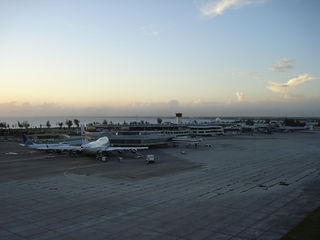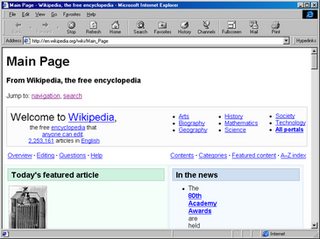
Hayling Island is an island off the south coast of England, in the borough of Havant in the county of Hampshire, east of Portsmouth.

The Neva, IPA: [nʲɪˈva]) is a river in northwestern Russia flowing from Lake Ladoga through the western part of Leningrad Oblast to the Neva Bay of the Gulf of Finland. Despite its modest length of 74 kilometres (46 mi), it is the fourth largest river in Europe in terms of average discharge.

Caddie is a mid-range computer-assisted draughting (CAD) software package for 2D and 3D design. It is used primarily by architects, but has tools for surveyors and mechanical, civil and construction engineers. It was initially designed as an electronic drawing board, using concepts and tools clearly related to a physical board.

Las Américas International Airport is an international airport located in Punta Caucedo, near Santo Domingo and Boca Chica in the Dominican Republic. The airport is run by Aeropuertos Dominicanos Siglo XXI (AERODOM), a private corporation based in the Dominican Republic under a 25-year concession to build, operate, and transfer (BOT) six of the country's airports. Las Américas usually receives a wide variety of long-, mid- and short-haul aircraft.

A corkscrew is a tool for drawing corks from wine bottles and other household bottles that may be sealed with corks. In its traditional form, a corkscrew simply consists of a pointed metallic helix attached to a handle, which the user screws into the cork and pulls to extract it. Corkscrews are necessary because corks themselves, being small and smooth, are difficult to grip and remove, particularly when inserted fully into an inflexible glass bottle. More recent styles of corkscrew incorporate various systems of levers that further increase the amount of force that can be applied outwards upon the cork, making easier the extraction of difficult corks.

Goring & Streatley railway station is on the Great Western Main Line serving the twin villages of Goring-on-Thames, Oxfordshire and Streatley, Berkshire in England. The station is in Goring-on-Thames, adjacent to the village centre and some five minutes walk from Goring and Streatley Bridge, which connects the village with Streatley, across the River Thames. It is 44 miles 60 chains (72.0 km) down the line from London Paddington and is situated between Pangbourne to the east and Cholsey to the west. It is served by local services operated by Great Western Railway (GWR).

Microsoft Internet Explorer 4 (IE4) is a graphical web browser that Microsoft released in October 1997, primarily for Microsoft Windows, but also with versions available for the classic Mac OS, Solaris, and HP-UX and marketed as "The Web the Way You Want It".

Neoclassical architecture is an architectural style produced by the Neoclassical movement that began in the mid-18th century in Italy and France.

The Willow pattern is a distinctive and elaborate chinoiserie pattern used on ceramic kitchen/housewares. It became popular at the end of the 18th century in England when, in its standard form, it was developed by English ceramic artists combining and adapting motifs inspired by fashionable hand-painted blue-and-white wares imported from China. Its creation occurred at a time when mass-production of decorative tableware, at Stoke-on-Trent and elsewhere, was already making use of engraved and printed glaze transfers, rather than hand-painting, for the application of ornament to standardized vessels.

Cast-iron architecture is the use of cast iron in buildings and objects, ranging from bridges and markets to warehouses, balconies and fences. Refinements developed during the Industrial Revolution in the late 18th century made cast iron relatively cheap and suitable for a range of uses, and by the mid 19th century it was common as a structural material, and particularly for elaborately patterned architectural elements such as fences and balconies, until it fell out of fashion after 1900 as a decorative material, and was replaced by modern steel and concrete for structural purposes.

Mail.Ru Group, ООО is a Russian internet company. It was started in 1998 as an e-mail service and went on to become a major corporate figure in the Russian-speaking segment of the Internet. As of 2013 according to comScore, websites owned by Mail.ru collectively had the largest audience in Russia and captured the most screen time.
Dell Force10, was a United States company that developed and marketed 10 Gigabit and 40 Gigabit Ethernet switches for computer networking to corporate, educational, and governmental customers. It had offices in North America, Europe, and the Asia Pacific region.
The Presnyakov Brothers are writers, playwrights, screenwriters, directors, theatre producers, and actor.

Alberto Blanco is considered one of Mexico's most important poets. Born in Mexico City on February 18, 1951, he spent his childhood and adolescence in that city, and he studied chemistry at the Universidad Iberoamericana and philosophy at the Universidad Nacional Autónoma de México. For two years, he pursued a master's degree in Asian Studies, specializing in China, at El Colegio de México.1 Blanco was first published in a journal in 1970. He was co-editor and designer of the poetry journal El Zaguan (1975–1977), and a grant recipient of the Centro Mexicano de Escritores, el Instituto Nacional de Bellas Artes, and the Fondo Nacional para la Cultura y las Artes. In 1991 he received a grant from the Fulbright Program as a poet-in-residence at the University of California, Irvine; and, in 1992, he was awarded a grant from the Rockefeller Foundation. He was admitted into the Sistema Nacional de Creadores in 1994, for which he has also been a juror. In 2001 he received the Octavio Paz Grant for Poetry, and in 2008, he was awarded a grant from the Guggenheim Foundation. He remains a member of the Sistema Nacional de Creadores.

Sebastian Copeland is a French-American-British photographer, polar explorer, author, lecturer, and environmental activist. He has led numerous expeditions in the polar regions to photograph and film endangered environments. In 2017, Copeland was named one of the world's top 25 adventurers of the last 25 years by Men's Journal. He is a fellow of The Explorers Club. His documentary Into the Cold was a featured selection at the 2010 Tribeca Film Festival and was released on DVD timed to Earth Day 2011.

Alexeevsky Palace is a Revivalist palace compound on the bank of the Moika River in Saint Petersburg. It was erected in the mid-1880s as a private residence of Grand Duke Alexis and his family.

Alfred Aleksandrovich Parland was a Russian architect born in St. Petersburg into an English family and baptized and confirmed in the Anglican Church. Son of Alexander Parland and Maria Caroline Parland (Hellmann), grandson of John Parland.
Johnston Street Bridge is a concrete road bridge crossing the Yarra River between the Melbourne suburbs of Abbotsford and Kew.

Park Glienicke, is an English landscape garden in the southwestern outskirts of Berlin, Germany. It is located in the locality of Wannsee in the Steglitz-Zehlendorf borough. Close to Glienicke Bridge the park is open to the general public. The park is part of the UNESCO World Heritage Site Palaces and Parks of Potsdam and Berlin. Within the ensemble it is one of the five main parks, the others being Sanssouci Park, New Garden, Babelsberg Park and Peacock Island (Pfaueninsel). Regarding diversity in gardening styles within the Potsdam park ensemble Park Glienicke is only superseded by Sanssouci Park. Furthermore, it is a park especially characterized by one personality due to the intense involvement of Prince Charles of Prussia. The park covers approximately 116 hectares

















